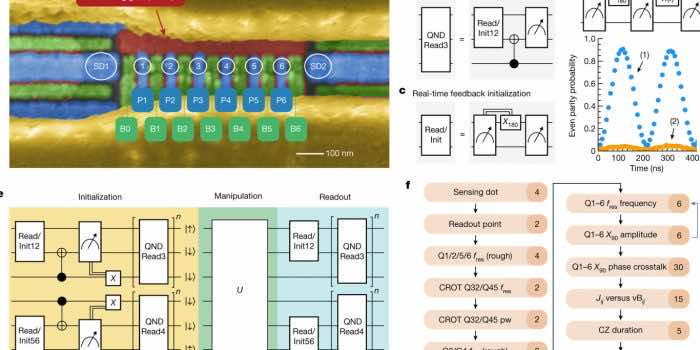To make entirely operational and capable quantum computers, researchers have made a breakthrough by completely controlling a 6-qubit quantum processor in silicon.
They have referred to it as “a major stepping stone” for the technology.
“The quantum computing challenge today consists of two parts,” says quantum computing researcher Stephan Philips from the Delft University of Technology in the Netherlands. “Developing qubits that are of good enough quality and developing an architecture that allows one to build large systems of qubits.”
“Our work fits into both categories. And since the overall goal of building a quantum computer is an enormous effort, I think it is fair to say we have made a contribution in the right direction.”
The qubits are made from separate units of electrons placed in a row, 90 nanometers apart (a human hair is around 75,000 nanometers in diameter). This line of ‘quantum dots’ is adjusted in silicon, with the help of a structure like that of the transistors used in standard processors.

The qubits are formed by tuning the voltage on the chip’s red, blue, and green wires. SD1 and SD2 are susceptible electric field sensors that can detect the charge of a single electron. These sensors along with advanced control schemes enable the researchers to place individual electrons at the locations labeled 1-6, which were then operated as qubits. (Philips et al., Nature, 2022)
The team was also successful to control their spin – the quantum mechanical property that allows the qubit state.
Researchers used microwave radiation, magnetic fields, and electric potentials to control and read electron spin, operating them as qubits. They were also successful in making them interact with each other as needed.
“In this research, we push the envelope of the number of qubits in silicon, and achieve high initialization fidelities, high readout fidelities, high single-qubit gate fidelities, and high two-qubit state fidelities,” says electrical engineer Lieven Vandersypen, also from the Delft University of Technology.

“What really stands out though is that we demonstrate all these characteristics together in one single experiment on a record number of qubits.”
“With careful engineering, it is possible to increase the silicon spin qubit count while keeping the same precision as for single qubits,” says electrical engineer Mateusz Madzik from the Delft University of Technology.
“The key building block developed in this research could be used to add even more qubits in the next iterations of study.”
The research has been published in Nature.


